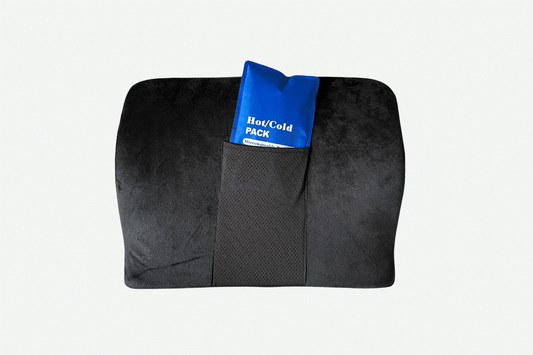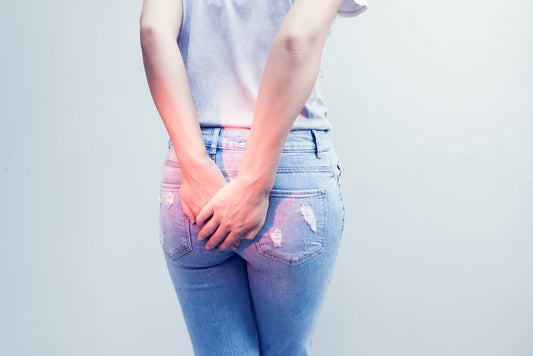How To Sleep With Thrombosed Hemorrhoids
Robert Cutler, D.O., FAOCPrShare
Losing sleep to a thrombosed hemorrhoid? While this blood clot within your hemorrhoid can cause serious pain, there are strategies for tackling the discomfort. And when it comes to sleep, don’t give up hope! Understanding methods for alleviating pain before bed will help you craft a nighttime routine designed to eliminate symptoms and get you the rest you need to heal.
What are Thrombosed Hemorrhoids?
Hemorrhoids are a cushion of veins and connective tissue that lie along your anal canal. When pressure is placed upon this region, it causes this set of veins to swell. The term “hemorrhoid” typically refers to the array of painful and aggravating symptoms triggered by this swelling.
Both internal and external hemorrhoids can form as a result of this pressure, each with their own set of symptoms. Internal hemorrhoids (remaining inside the rectum) are generally painless and may only even be discovered via drops of blood on toilet paper or in stool. External hemorrhoids develop under the skin around your anus and cause itching, redness and irritation. Prolapsed internal hemorrhoids have become so enlarged that they bulge out of the anus.
Thrombosed hemorrhoids occur when blood clots form within these affected veins. Blood clots appear when platelets and fibrin clump together in a gel-like mass, obstructing the normal flow of blood. Whether it is internal or external, a thrombosed hemorrhoid can be cause for concern. The increase in inflammation means a more painful, consistent throbbing that can affect daily functioning, particularly when it comes to sleep.
Causes of Thrombosed Hemorrhoids
Thrombosed hemorrhoids are a result of many of the same sources behind more general hemorrhoid swelling. Excess pressure placed on the rectum disrupts regular blood flow to these veins, causing the blood to pool and enlarging the veins. Added pressure as a result of pregnancy, obesity and lifting heavy objects can all contribute. Straining from chronic constipation, diarrhea or even holding in your bowel movements for extended periods of time can cause pressure.
Thrombosed hemorrhoids in particular may be a direct consequence of prolonged periods of sitting. Whether this means a long car ride, working at a seated desk or using your phone while on the toilet, the amount of time we spend seated can quickly add up. As a result of gravity, when in a seated position your blood begins to clot and pool into your lower extremities. The cut-out design of your standard toilet seat drops your rectum below the rest of your body, creating a perfect storm for thrombosed hemorrhoids.
Learn more about the best sitting positions for hemorrhoids (and what to avoid!).
Challenges Faced When Sleeping With Thrombosed Hemorrhoids
Thrombosed hemorrhoids are notorious for their increased level of pain, and even sleeping isn’t safe from the suffering. Why are hemorrhoids worse at night? This isn’t the case for everyone with hemorrhoids, but some people experience a surge in pain as your body attempts to fall asleep. This may be the natural result of a slow down in the production of cortisol at the onset of sleep1, a key component in immune and inflammatory system functioning2. A thrombosed hemorrhoid is a hotbed of inflammation, and this circadian shut-down impacts your body’s ability to stem the pain.
But it could also be that during the day your mind is busy with other things, and when you lie down to go to bed the things that subtly bother you over the course of a day become more noticeable, including hemorrhoid-related symptoms.
Pressure is an issue for hemorrhoids day and night. The impact of the combined pressure placed on your rectum via standing, sitting and straining during bathroom use on a daily basis leaves your thrombosed hemorrhoid with a heavy load by the time you get to bed. Choosing a sleeping position that minimizes the effects of this accumulated pressure and prevents it from continuing throughout the night is essential for successfully sleeping with thrombosed hemorrhoids.
Nighttime can also pose a challenge to the more surface-level symptoms that arise as a result of a thrombosed hemorrhoid. We often sweat in our sleep, and this may exacerbate itching, burning, irritation and redness around the hemorrhoid. If the sweat gets trapped, it also poses an increased risk of bacteria and infection.
Sleep is essential for your body as it heals the hemorrhoid site. Important tissue growth and renewal occurs only during the sleep process, and the rate of healing is greater during sleep3. Fitful or disruptive sleep that prevents your body from entering stages of deep and REM sleep also acts as a psychological deterrent, as mental stress negatively impacts wound repair4.
Sleeping Techniques and Positions for Hemorrhoid Sufferers
While sleeping with hemorrhoids can feel like a losing battle, there are plenty of strategies to help you find relief at night. Thrombosed hemorrhoids in particular make finding the sleep position that works best for the placement of your hemorrhoid site essential. What alleviates symptoms for some may not be the best position for others, so paying close attention to your own pain points is always the most direct route for finding out how to relieve hemorrhoid pain at night.
Best Sleeping Positions
As with sitting for too long, lying in a position that places excess pressure on your thrombosed hemorrhoid will exacerbate the pain. Even if you do manage to sleep through it, the accumulated damage may wreak havoc on your hemorrhoid come morning. Finding the best sleeping position for hemorrhoids can take some experimenting. Typically, lying on your back causes weight to come down right where gravity is pushing it – onto your hemorrhoid. Sticking to a sleep position on your stomach or side during the first 48–72 hours of a thrombosed hemorrhoid (when the pain is most acute) may help alleviate the worst of it.
Using Pillows for Support
Pillows are our friend, and they aren’t just for weary heads drifting off to dreamland anymore. A strategically placed pillow can do wonders for the nighttime hemorrhoid sufferers among us. If you’ve found sleeping on your stomach more agreeable, a pillow tucked below your knees or under your hips will help reduce even more pressure from hitting your hemorrhoid. A regular pillow will work just fine, but you can find a wedge-shaped pillow designed to elevate your hips or knees further.
Similarly, side sleepers can also use a pillow to enhance the position’s success in lifting pressure off the thrombosed hemorrhoid. Placing a pillow between your knees will help correct the alignment of your hips and spine, removing weight from the hemorrhoid site. A standard pillow simply placed between the knees will suffice, though ergonomically designed models – some even with straps or built-in loops to keep the pillow in place overnight – are also available.

Importance of a Firm Mattress
Imagine yourself on a soft mattress. You may find that blissful, sinking feeling helps you sleep, but unfortunately it’s wreaking havoc on your thrombosed hemorrhoid.

Soft mattresses create a boomerang effect, where the middle portion of your body (aka the weight bearing section) sinks lower into the mattress than the rest of you. As we have discussed, this means a pressure point forms precisely at the site of your hemorrhoid.
Choosing a firmer mattress helps ensure that your hips stay in alignment with your shoulders and knees while you sleep, preventing the loss of blood flow or risk of further pooling to your hemorrhoid. However, if you can’t get to sleep on a firm mattress, it won’t solve the problem of sleeping with a hemorrhoid because sleeping itself is an important time for skin healing as we talked about earlier.
Choosing a soft mattress and using pillows and different sleep positions to offset the potential for sinking is an option if your ability to sleep is entirely negated by the thought of a firm mattress. However, don’t be surprised what a little acute pain does to open the mind to a firmer option.
Bedtime Routines to Ease Hemorrhoid Discomfort
Sleep hygiene has become a widely used term5 as researchers begin to study the impacts of our pre-bedtime rituals on the quality of our slumber. This same attention to detail goes a long way when it comes to nighttime hemorrhoid hygiene. Developing a routine to help prepare the body against disrupted sleep as a result of thrombosed hemorrhoids will help drive successful outcomes.
Warm Sitz Baths
Taking a bath before bed isn’t just child’s play. Sitz baths are a well known remedy for hemorrhoid pain and offer an array of additional side benefits. By simply filling your tub with one to two inches of warm water and soaking the affected area for ten to twenty minutes, you are increasing blood flow and relaxing your anal sphincter. Done immediately before bed, this offers a boost of relief in time for the vulnerable period immediately before falling asleep.
Thrombosed hemorrhoids are also notoriously difficult to keep clean as a result of the pain and placement of the clot itself. Sitz baths are an easy and painless way to make sure the area is staying hygienic and free from irritation via toilet paper and even wipes. This will also help prevent any lingering burning or stinging of the surrounding skin from kicking in as you’re trying to sleep.
Over-the-Counter Products
The same products that help with symptom relief during the day can be a useful tool in the fight to sleep with a thrombosed hemorrhoid. Over-the-counter hemorrhoid products like creams and ointments use active ingredients that will numb swelling and irritation, allowing you to fall asleep before their potency begins to wear off. For extremely delicate or raw skin, it may even be easier to apply this medicine in the form of a touch-free spray.
As with all over-the-counter products, follow the given instructions and consult your physician before use as an overnight treatment. And remember, while these at-home treatments target symptoms, the pain of thrombosed hemorrhoids is usually a result of the pressure of the blood clot pushing against the tissue so be sure you take steps to find a sleep position that reduces, instead of adds, pressure.
Loose-Fitting Clothing
There are a few things to keep in mind when choosing sleepwear as a hemorrhoid sufferer. The best choice, of course, is to choose nothing – sleeping nude eliminates the potential for moisture build-up and irritation. If this isn’t possible, loose cotton garments will prevent sweat and other moisture from getting trapped and exacerbating symptoms as you sleep. Cotton is naturally a hollow fiber, allowing air to pass through it even when tightly woven. It also absorbs moisture, making it the perfect fabric when dealing with thrombosed hemorrhoids.
When Should You Seek Medical Advice?
Thrombosed hemorrhoids typically take care of themselves after a few weeks (especially with proper care and at-home treatment). For particularly painful instances, a doctor can remove the blood clot within the first 24-72 hours of its formation. As with all hemorrhoids, any severe pain or increase in bleeding warrants immediate medical attention. Bright red blood may mean that the thrombosed hemorrhoid has ruptured, but can also indicate a more serious condition such as ulcerative colitis or colorectal cancer. A medical screening will confirm the source of the bleeding and get you on track for proper care.
Further Tips to Prevent Thrombosed Hemorrhoids
Daily habits have an effect on the prevention and management of hemorrhoids. By introducing these tips into your lifestyle, you can positively impact your hemorrhoid health and ensure thrombosed hemorrhoids heal fast.
- Increase fiber - Eating a proper amount of fruit, vegetables and whole grains helps regulate your digestion and keeps things flowing.
- Stay hydrated - Consuming enough liquid keeps your bowel movements smooth and easy to pass.
- Exercise regularly - Improve your circulation, strengthen your abdominal muscles and stimulate your bowels by staying active.
FAQs About Thrombosed Hemorrhoids
How do thrombosed hemorrhoids impact sleep?
The acute and aching pain of thrombosed hemorrhoids can make it difficult to fall asleep. Regular sleeping positions may exacerbate the issue, forcing you to add pillows or switch from your regular position to alleviate pressure on the hemorrhoid. Preventative measures should be taken to help prevent the thrombosed hemorrhoid from trapping sweat and bacteria overnight, and pre-sleep routine may be necessary to stimulate blood flow to the hemorrhoid site before your body enters the sleep cycle.
How long do thrombosed hemorrhoids typically take to heal?
The sometimes searing initial pain of a thrombosed hemorrhoid should subside in 24 to 72 hours. The local pain that follows usually takes 7-10 days, and the thrombosed hemorrhoid itself (including the lump it forms) will typically take 2-3 weeks to disappear. Acute pain that does not subside after 72 hours of the clot forming is cause for immediate medical attention.
What are the best bed linens to use if I have hemorrhoids?
Similar to the loose, cotton clothing we recommend wearing to sleep with hemorrhoids, your bed linens should be made of a breathable material. Sheets that are specifically designed to keep you cool or marketed for ‘hot sleepers’ may help prevent you from sweating in your sleep. Avoid synthetic fibers and high thread counts, which even in cotton sheets means more significant heat retention.
Are there any sleep aids that are safe to use when experiencing hemorrhoid pain?
The same over-the-counter oral pain relievers that you use during the day may be taken before bed for pain relief. Medicine specifically designed as a sleep aid is not recommended to treat thrombosed hemorrhoids. The function of sleeping pills is to help you sleep, and they do not target the inflammation, pain and swelling. That said, any sleep aids you’re used to taking aren’t a problem to use during a flare up if that’s your question.
Are there any nighttime activities I should avoid with thrombosed hemorrhoids?
Activities that involve painful movement or put the thrombosed hemorrhoid at risk of bursting are not recommended day or night. Sitting up in bed to watch tv or read may cause the blood to pool, leaving you with greater pain as you try to sleep.
Say Goodnight to Hemorrhoid Pain with Doctor Butler's!
Now that you know how to sleep with hemorrhoids, restless nights are a thing of the past. Doctor Butler’s is here to support you with the hemorrhoid pain relief products you need to ensure a healthy, restful bedtime for the pain-free days ahead.
Citations
- Balbo M, Leproult R, Van Cauter E. Impact of sleep and its disturbances on hypothalamo-pituitary-adrenal axis activity. Int J Endocrinol. 2010;2010:759234. doi: 10.1155/2010/759234. Epub 2010 Jun 9. PMID: 20628523; PMCID: PMC2902103
- Sapolsky R.M., Romero L.M., Munck A.U. How Do Glucocorticoids Influence Stress Responses? Integrating Permissive, Suppressive, Stimulatory, and Preparative Actions∗ Endocrin. Rev. 2000;21:55–89.
- Adam, K., & Oswald, I. (1984). Sleep helps healing. British medical journal (Clinical research ed.), 289(6456), 1400–1401. https://doi.org/10.1136/bmj.289.6456.1400
- Gouin, J. P., & Kiecolt-Glaser, J. K. (2011). The impact of psychological stress on wound healing: methods and mechanisms. Immunology and allergy clinics of North America, 31(1), 81–93. https://doi.org/10.1016/j.iac.2010.09.010
- Alanazi, E. M., Alanazi, A. M. M., Albuhairy, A. H., & Alanazi, A. A. A. (2023). Sleep Hygiene Practices and Its Impact on Mental Health and Functional Performance Among Adults in Tabuk City: A Cross-Sectional Study. Cureus, 15(3), e36221. https://doi.org/10.7759/cureus.36221


